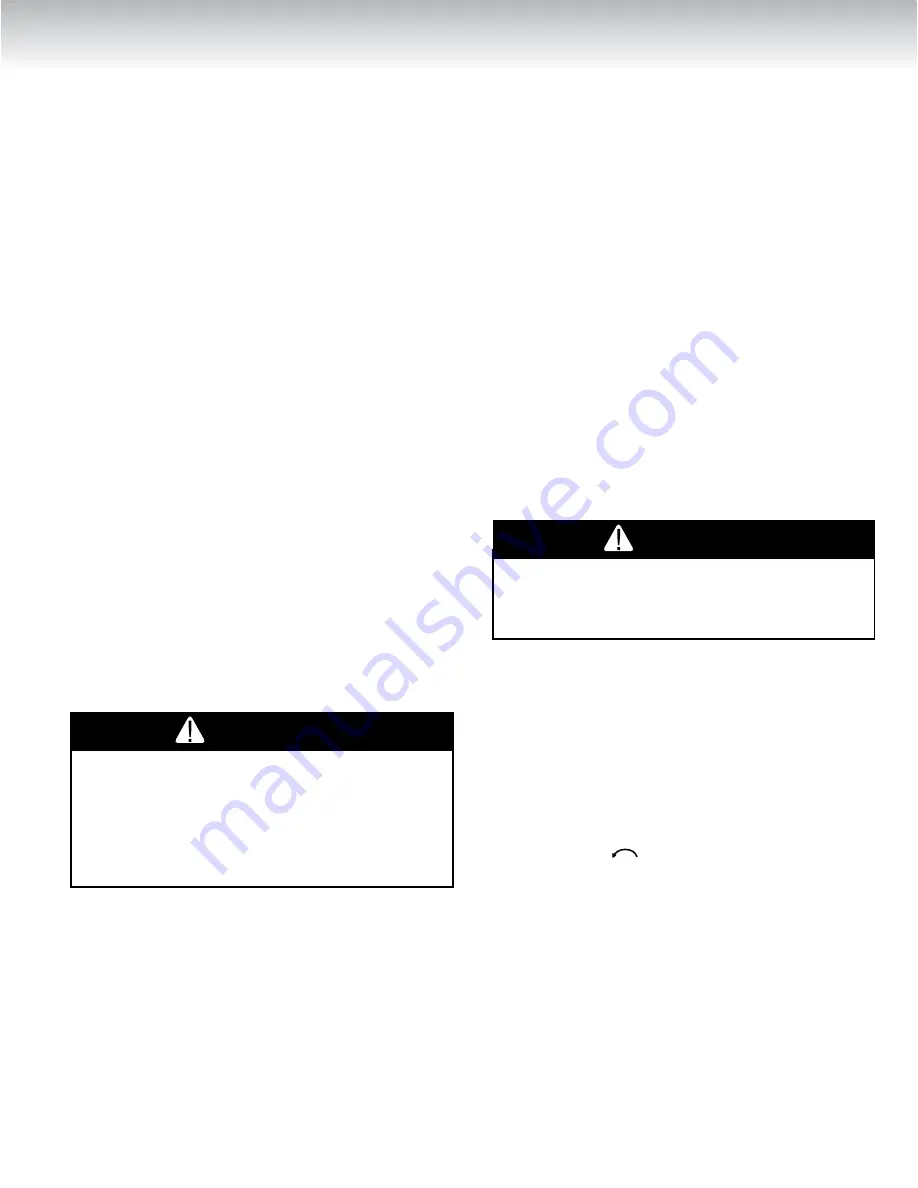
9
GENERAL MAINTENANCE
Start-up Procedure
1) Turn on the circuit breaker at the main service panel.
2) Make sure the fuse box or power switch (if one exists) next to the
water heater is pushed to “ON”.
3) If you smell smoke, refer to What to do if you smell smoke.
4) Wait one (1) hour. At this time, hot water should be available at the
faucet.
5) If after one (1) hour you do not have any hot water, check that the
fuse or circuit breaker is in working condition.
6) Wait another hour. If at this time you still do not have any hot
water, call a qualified service technician.
Note: If after one (1) hour you receive only a small amount of hot
water, check that the plumbing connections are not reversed.
Safety Controls
This water heater is equipped with a combination thermostat and high
limit reset control (ECO) that is located above the upper heating element.
If for any reason the temperature of the water becomes excessively high,
the ECO will break the power circuit to the heating element. Once the
control opens, it must be reset manually.
To reset the ECO:
1) Turn “OFF” the power to the water heater.
2) Remove the upper element and thermostat access door and the
insulation.
3) Press the red RESET button.
4) Replace the insulation and the element and thermostat access
door before turning “ON” the power to the water heater.
Water Temperature Regulation
The higher the setting, the greater the risk of scalding. Hot water
can cause third degree burns in under one (1) second at 160˚F
(71˚C), in six (6) seconds at 140˚F (60˚C), and in thirty (30)
seconds at 130˚F (54˚C). In households where there are
children, physically challenged individuals, or elderly persons,
mixing valves for point of use are necessary as means of reducing
the scalding potential of hot water.
The thermostat is factory set at 140˚F (60˚C) for Canadian models
and 125˚F (52˚C) for U.S. models.
To adjust the temperature on the thermostat:
1) Turn “OFF” the power to the water heater.
2) Remove the element and thermostat access door and the insulation.
On U.S. models DO NOT remove the thermostat protective cover.
3) Using a small flathead screwdriver, turn the thermostat dial to the
desired temperature.
4) Replace the insulation and the element and thermostat access
door before turning “ON” the power to the water heater.
Condensation
Condensation can form on the surface of the water heater:
1) When the water heater is filled with cold water for the first time.
2) If the water heater has been undersized.
3) When large amounts of hot water are drawn from the water heater
in a short period of time, and the refill water is very cold.
This condition is not uncommon and must never be misinterpreted
as a leaking tank. It will disappear once the water becomes heated.
Because the water can condense, it is very important that a drain
pan be installed under the water heater (refer to Figure 1A or
1B). Under no circumstances is the manufactu rer to be held
liable for any water damage, in connection with this water
heater.
If the problem does not go away and water continues
to drip after the water heater has heated up, check all of the
plumbing connections to make sure they are not leaking.
Water Heater Tank
Drain a pail of water through the drain valve at least once a year.
This will remove excess sediment from the bottom of the tank. This
sediment, if allowed to accumulate, will reduce the efficiency and the
life of the tank.
Element or Thermostat Replacement
Before attempting to repair or replace any of the electrical
components on this water heater, turn “OFF” the power to the
water heater. Failure to do so could result in electrical shock and/
or property damage, personal injury, or death.
Replacing an Element (See Figure 3)
1) Turn “OFF” the power to the water heater and drain all of the water
from the water heater (see Draining the Water Heater, page 11).
2) Remove the element and thermostat access door and the insulation.
3) Disconnect the wires from the element terminals.
4) For a square flange element, undo the four (4) bolts securing the
element to the water heater.
For a screw-in element, with the help of a 1.5 inch socket wrench,
remove the element by unscrewing it from the water heater in a
counterclockwise
motion.
For TWIST-LOCK system, unscrew the four (4) bolts securing the
element to the water heater and pull element out of the tank. Make
sure the TWIST-LOCK flange is in the right position (See Figure 4).
5) Replace the element with a new element of the same wattage and
voltage. Make sure that the gasket surface is clean and that the
element has been re-installed water-tight with a new gasket.
6) Re-connect the wiring and tighten securely.
7) Re-fill the water heater (see Filing the Water Heater, page 3). DO
NOT TURN THE POWER ON TO THE WATER HEATER UNLESS
YOU ARE SURE IT IS COMPLETELY FILLED WITH WATER.
8) Inspect for any leaks and repair, if necessary
9) Replace the insulation and element and thermostat access door
before turning “ON” the power to the water heater.
WARNING
WARNING




















